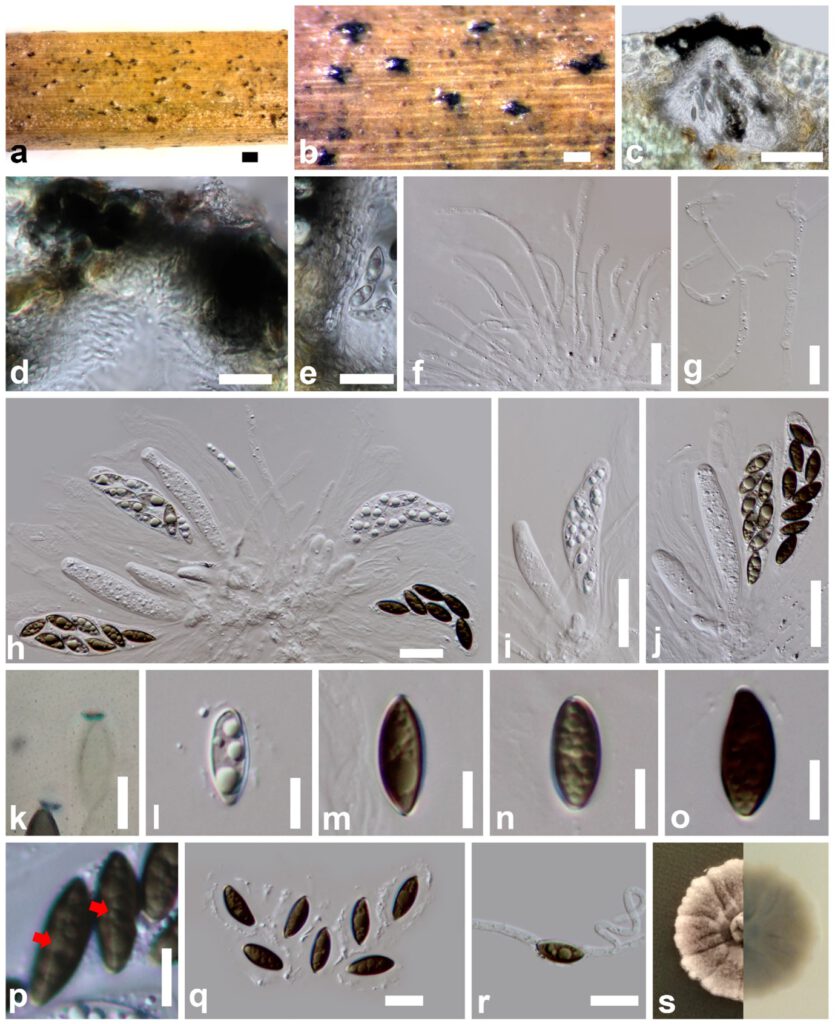Xenoanthostomella calami Konta & K.D. Hyde, in Konta, Tibpromma, Karunarathna, Samarakoon, Steven, Mapook, Boonmee, Senwanna, Balasuriya, Eungwanichayapant & Hyde, Mycosphere 14(1): 137 (2023)
Index Fungorum number: IF 559682; MycoBank number: MB 559682; Facesoffungi number: FoF 10828;
Etymology – Refers to the host genus Calamus.
Holotype – MFLU 15-0003.
Saprobic on dead rachis of Calamus sp. Sexual morph: Ascomata 100–150 × 60–145 μm (x̄ = 125 × 115 μm, n = 20), solitary, immersed, visible as a black spot, raised, thick carbonaceous cap, in cross-section ampulliform to ovoid or oppyriform to irregular. Ostioles central, 48–58 × 63–82.5 μm (x̄ = 52 × 73 μm, n = 20), shiny black, conspicuous, ostiolar canal periphyses. Peridium 7.7–60 μm wide (x̄ = 27.5 μm, n = 40), comprising hyaline to brown cells of textura angularis. Hamathecium 1.3–5.8 μm (x̄ = 3.6 μm, n = 70) wide, long, cylindrical, septate with small guttules, hyaline, smooth-walled, paraphyses. Asci 50–90 × 10–16 μm (x̄ = 67.5 × 13 μm, n = 30), 6–8-spored, unitunicate, clavate, constricted nearby the apex, discoid, apical ring, J+ in Melzer’s reagent, apex rounded, short pedicellate. Ascospores 11–16 × 4–7 μm (x̄ = 12.4 × 5.3 μm, n = 40), uni to bi-seriate, hyaline to pale brown when immature, dark olivaceous-brown at maturity, 1–3-large guttules when immature, multi-granule at maturity, oblong to narrowly ellipsoid, inequilateral to broadly fusiform, slightly curved, limoniform, aseptate, thick mucilaginous sheath, with a straight germ slit along the entire spore length. Asexual morph: Undetermined.

Fig. 1. Xenoanthostomella calami (MFLU 15-0003, holotype). a, b Appearance of ascoma on the substrate c Section through of ascoma. d Periphyese. e Peridium. f, g Paraphyses. h–j Asci. k J+ apical ring. l–o Ascospores. p Germ slit. q Mature ascospores with a mucilaginous sheath. r Germinated ascospore. s Colony on MEA. Scale bars: a = 500 μm, b = 200 μm, c = 50 μm, d–j = 20 μm, k–p = 5 μm, q, r = 10 μm.
